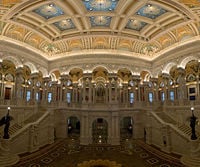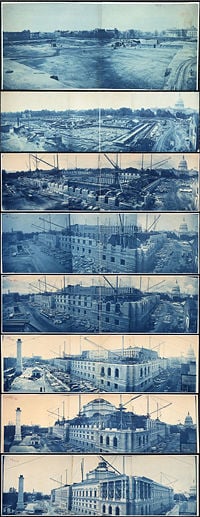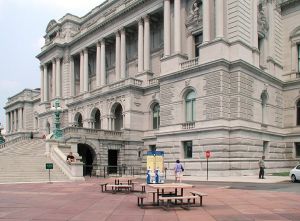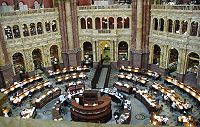Difference between revisions of "Library of Congress" - New World Encyclopedia
m |
m (→History) |
||
| Line 8: | Line 8: | ||
[[Image:Loc contruction.jpg|thumbnail|200px|right|Construction of the Thomas Jefferson Building, from July 8, 1888 to May 15, 1894.]] | [[Image:Loc contruction.jpg|thumbnail|200px|right|Construction of the Thomas Jefferson Building, from July 8, 1888 to May 15, 1894.]] | ||
| − | The Library of Congress was established on | + | The Library of Congress was established on April 24, 1800 when President John Adams signed an act of Congress allowing for the transfer of the U.S. Government body from Philadelphia, Pennsylvania to the new capital city of Washington, D.C. |
| − | |||
| − | |||
| − | + | The legislation appropriated $5,000 for the purchase of a collection of books deemed necessary for the use of Congress, and for fitting the establishment of a suitable apartment for containing them. The original library was housed in the new U.S. Capitol until August 1814, when invading British troops set fire to the Capitol building during the Burning of Washington, destroying the contents of the 3,000 volume library. | |
| − | |||
| − | |||
| − | |||
| − | |||
| − | + | Within a month, former President Thomas Jefferson offered his personal library as a replacement. Jefferson’s library was considered to be one of the finest in the United States as the President had spent more than 50 years accumulating books. Jefferson, who was heavily indebted at the time, sought to use the proceeds of the sale of his books to satisfy his creditors. He also anticipated some controversy over the nature of his collection, which included books in foreign languages and volumes of philosophy, science, literature, and other topics not normally viewed as part of a legislative library. | |
| − | On | + | In January 1815, Congress accepted Jefferson's offer, appropriating $23,950 for his 6,487 books, and the foundation was laid for a great national library. The Jeffersonian concept of universality, the belief that all subjects are important to the library of the American legislature, is the philosophy and rationale behind the comprehensive collection policy of today's Library of Congress. |
| + | |||
| + | On December 24, 1851, a fire would destroy the library’s 35,000 books, an original portrait of Christopher Columbus, portraits of the first five Presidents, and statues of George Washington, Thomas Jefferson and Marquis de Lafayette. | ||
[[Image:LibraryCongressWashDC.jpg|thumbnail|203px|left|Main Library of Congress Building at the start of the 20th century.]] | [[Image:LibraryCongressWashDC.jpg|thumbnail|203px|left|Main Library of Congress Building at the start of the 20th century.]] | ||
| − | |||
| − | |||
| − | |||
| − | |||
| − | |||
| − | In | + | The Library is now spread over three buildings in Washington, D.C and encompasses the 1897 Thomas Jefferson Building, the 1938 John Adams Building and the 1981 James Madison Memorial Building. In November of 2005, the Library announced its intentions to launch the World Digital Library, a digital preservation of books and other objects from cultures all over the world. |
==Holdings== | ==Holdings== | ||
Revision as of 16:43, 3 August 2006
The Library of Congress is the national library of the United States and represents the research arm of the U.S. Congress. It is one of the largest libraries in the world and holds more than 29 million books and printed materials in 470 languages, over 1 million US Government publications, 1 million issues of world newspapers spanning the past three centuries, 33,000 bound newspaper volumes, 500,000 microfilm reels, and over 6,000 comic books. It is also home to the world's largest collection of legal materials, and interactive media items including films, 4.8 million maps, sheet music and 2.7 million sound recordings. The library also holds the largest rare book collection in North America, including a Gutenberg Bible, and more than 58 million manuscripts. The head of the Library is the Librarian of Congress.
History
The Library of Congress was established on April 24, 1800 when President John Adams signed an act of Congress allowing for the transfer of the U.S. Government body from Philadelphia, Pennsylvania to the new capital city of Washington, D.C.
The legislation appropriated $5,000 for the purchase of a collection of books deemed necessary for the use of Congress, and for fitting the establishment of a suitable apartment for containing them. The original library was housed in the new U.S. Capitol until August 1814, when invading British troops set fire to the Capitol building during the Burning of Washington, destroying the contents of the 3,000 volume library.
Within a month, former President Thomas Jefferson offered his personal library as a replacement. Jefferson’s library was considered to be one of the finest in the United States as the President had spent more than 50 years accumulating books. Jefferson, who was heavily indebted at the time, sought to use the proceeds of the sale of his books to satisfy his creditors. He also anticipated some controversy over the nature of his collection, which included books in foreign languages and volumes of philosophy, science, literature, and other topics not normally viewed as part of a legislative library.
In January 1815, Congress accepted Jefferson's offer, appropriating $23,950 for his 6,487 books, and the foundation was laid for a great national library. The Jeffersonian concept of universality, the belief that all subjects are important to the library of the American legislature, is the philosophy and rationale behind the comprehensive collection policy of today's Library of Congress.
On December 24, 1851, a fire would destroy the library’s 35,000 books, an original portrait of Christopher Columbus, portraits of the first five Presidents, and statues of George Washington, Thomas Jefferson and Marquis de Lafayette.
The Library is now spread over three buildings in Washington, D.C and encompasses the 1897 Thomas Jefferson Building, the 1938 John Adams Building and the 1981 James Madison Memorial Building. In November of 2005, the Library announced its intentions to launch the World Digital Library, a digital preservation of books and other objects from cultures all over the world.
Holdings
The Library developed a system of book classification called Library of Congress Classification (LC) which is used by most US research and university libraries, although most public libraries continue to use the Dewey decimal system.
The Library serves as a legal repository for copyright protection and copyright registration, and as the base for the United States Copyright Office. Regardless of whether they are seeking copyright, all publishers are required to submit two copies of their copyrightable works to the Library - this requirement is known as mandatory deposit[1]. Nearly 22,000 new items published in the U.S. arrive every business day at the Library. Contrary to popular belief, however, the Library does not retain all of these works in its permanent collection, although it does add an average of 10,000 items per day. Rejected items are used in trades with other libraries around the world, distributed to federal agencies, or donated to schools, communities, and other organizations within the United States. [2] As is true of many similar libraries, the Library of Congress retains copies of every publication in the English language which is deemed significant.
The Guinness Book of World Records currently lists the Library of Congress as the "Largest Library" [1]. This apparently is based on the shelf space the collection occupies; the Library of Congress states that its collection fills about 530 miles (850 km),[2] while the British Library, reports about 388 miles (625 km) of shelves[3] The Library of Congress holds about 130 million items with 29 million books[4] against approximately 150 million items with 25 million books for the British Library.[5]
It is estimated that the print holdings of the Library of Congress would, if digitized and stored as plain text, constitute 17 to 20 terabytes of information. This leads many people to conclude that 20 terabytes is equivalent to the entire holdings of the Library, but this is misleading because many items have not been digitized, and not all of them consist of plain text. (Occasionally, this figure has been referred to as a data transfer rate, LoC/s—Libraries of Congress per second – defined as 20 terabytes of data transferred per second). The Library currently has no plans for systematic digitization of any significant portion of its books.
The Library makes millions of digital objects, comprising tens of terabytes, available at its American Memory site. American Memory is a source for public domain image resources, as well as audio, video, and archived Web content. Nearly all of the lists of holdings, the catalogs of the library, can be consulted directly on its web site. Librarians all over the world consult these catalogs, through the Web or through other media better suited to their needs, when they need to catalog for their collection a book published in the United States. They use the Library of Congress Control Number to make sure of the exact identity of the book.
The Library of Congress also provides an on-line archive of the proceedings of the U.S. Congress at Thomas, including bill text, Congressional Record text, bill summary and status, the Congressional Record Index, and the United States Constitution.
The Library also administers the National Library Service for the Blind and Physically Handicapped, a talking and Braille library program provided to more than 766,000 Americans.
Using the Library
The library is open to the general public for academic research, and runs tours for visitors. Only those who are issued a "Reader Identification Card" may enter the reading rooms and access the collection. The Reader Identification Card is available in the Madison building to persons who are over 18 years of age upon presentation of a government issued picture identification (e.g., driver's license, state ID card or passport). However, only members of Congress, their staff and certain other government officials can actually check out books. Supreme Court Justices and their clerks/staff can also check out books.
University libraries in the United States may request items through interlibrary loan from the Library of Congress if no other American institution possesses the item.
Standards
In addition to its library services, the Library of Congress is also actively involved in various standard activities in areas related to bibliographical and search and retrieve standards. Areas of work include METS, MODS, Z39.50 and SRW/SRU.
Annual events
Annual events include:
- The National Book Festival
- Founder's Day Celebration
- Archives Fair
- Judith P. Austin Memorial Lecture
- Davidson Fellows Reception
Notes and references
External links
- The Library of Congress website
- History of the Library of Congress
- American Memory
- thomas.loc.gov, legislative information
- Standards, The Library of Congress
Credits
New World Encyclopedia writers and editors rewrote and completed the Wikipedia article in accordance with New World Encyclopedia standards. This article abides by terms of the Creative Commons CC-by-sa 3.0 License (CC-by-sa), which may be used and disseminated with proper attribution. Credit is due under the terms of this license that can reference both the New World Encyclopedia contributors and the selfless volunteer contributors of the Wikimedia Foundation. To cite this article click here for a list of acceptable citing formats.The history of earlier contributions by wikipedians is accessible to researchers here:
The history of this article since it was imported to New World Encyclopedia:
Note: Some restrictions may apply to use of individual images which are separately licensed.




